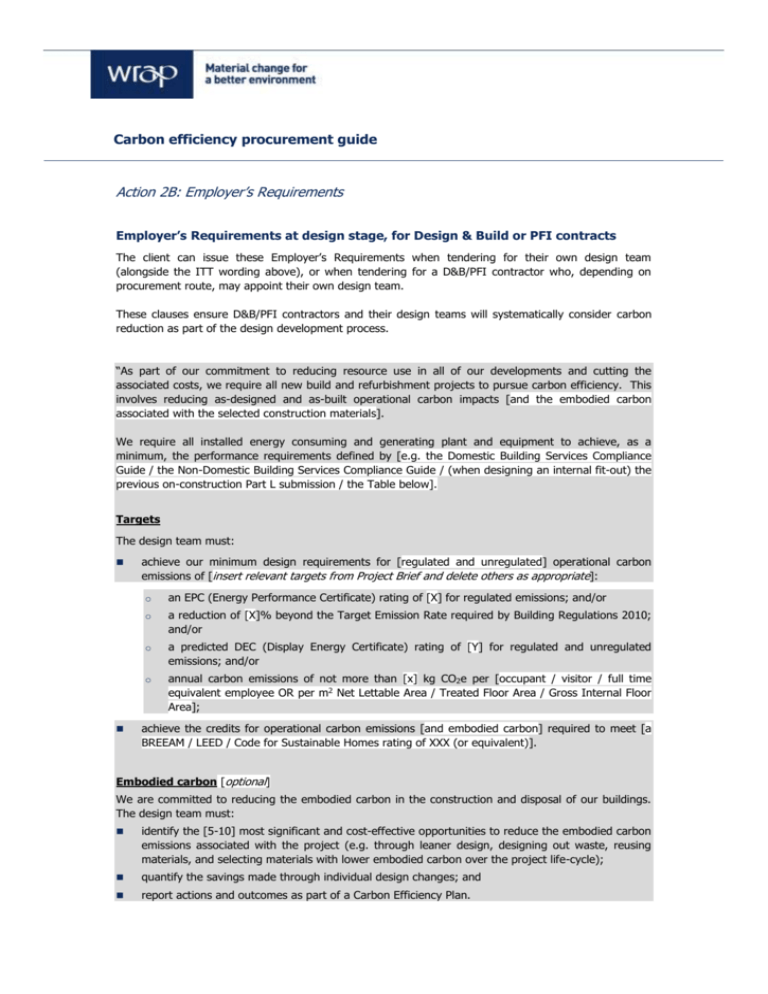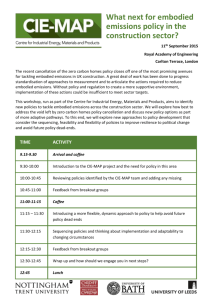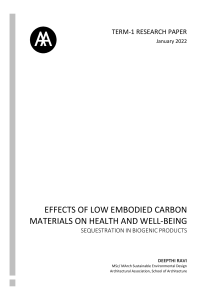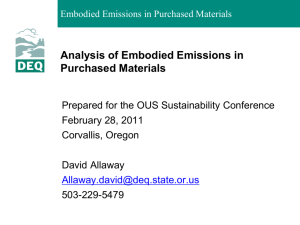Construction procurement guidance
advertisement

Carbon efficiency procurement guide Action 2B: Employer’s Requirements Employer’s Requirements at design stage, for Design & Build or PFI contracts The client can issue these Employer’s Requirements when tendering for their own design team (alongside the ITT wording above), or when tendering for a D&B/PFI contractor who, depending on procurement route, may appoint their own design team. These clauses ensure D&B/PFI contractors and their design teams will systematically consider carbon reduction as part of the design development process. “As part of our commitment to reducing resource use in all of our developments and cutting the associated costs, we require all new build and refurbishment projects to pursue carbon efficiency. This involves reducing as-designed and as-built operational carbon impacts [and the embodied carbon associated with the selected construction materials]. We require all installed energy consuming and generating plant and equipment to achieve, as a minimum, the performance requirements defined by [e.g. the Domestic Building Services Compliance Guide / the Non-Domestic Building Services Compliance Guide / (when designing an internal fit-out) the previous on-construction Part L submission / the Table below]. Targets The design team must: achieve our minimum design requirements for [regulated and unregulated] operational carbon emissions of [insert relevant targets from Project Brief and delete others as appropriate]: o an EPC (Energy Performance Certificate) rating of [X] for regulated emissions; and/or o a reduction of [X]% beyond the Target Emission Rate required by Building Regulations 2010; and/or o a predicted DEC (Display Energy Certificate) rating of [Y] for regulated and unregulated emissions; and/or o annual carbon emissions of not more than [x] kg CO2e per [occupant / visitor / full time equivalent employee OR per m2 Net Lettable Area / Treated Floor Area / Gross Internal Floor Area]; achieve the credits for operational carbon emissions [and embodied carbon] required to meet [a BREEAM / LEED / Code for Sustainable Homes rating of XXX (or equivalent)]. Embodied carbon [optional] We are committed to reducing the embodied carbon in the construction and disposal of our buildings. The design team must: identify the [5-10] most significant and cost-effective opportunities to reduce the embodied carbon emissions associated with the project (e.g. through leaner design, designing out waste, reusing materials, and selecting materials with lower embodied carbon over the project life-cycle); quantify the savings made through individual design changes; and report actions and outcomes as part of a Carbon Efficiency Plan. Carbon efficiency procurement guide Carbon Efficiency Plan The design team is required to develop a Carbon Efficiency Plan (CEP) for the project (or equivalent), commencing at the concept design stage or before. The CEP should include: a forecast for operational energy and associated carbon emissions (including regulated and unregulated emissions), taking account of: o building-level emissions considered within the Building Regulations asset rating (as quantified using SAP/SBEM tools); o key features that demonstrate compliance or improvement on the asset rating; o building-level emissions for significant energy uses not considered within the asset rating, such as: [delete as appropriate] o external and/or sports pitch lighting; regional IT server racks; communal facilities; catering facilities; multimedia; etc. adjustments to particular values within the national calculation methodology used to establish the asset rating and forecast, taking account of: ramp-up of building occupancy levels daily and seasonal profiles of usage; impact of energy management practices in operation; performance of low carbon and renewable energy technologies; etc. a cost-effective, project-specific target which meets or exceeds regulatory requirements: o reducing the building’s energy requirements in preference to supplying more low carbon energy; o predicting the carbon savings from passive design and proposed technical solutions; o avoiding excessive responsibility on facilities management or building users to achieve the design target under normal operation; and o providing a basis for monitoring and evaluation of actions to reduce operational carbon; the key design parameters by which the target will be achieved, including accepted performance tolerances and verification procedures; actions to be taken in design, equipment specification, construction, commissioning and postcompletion to reduce carbon emissions and ensure effective implementation (with clearly identified responsibilities of relevant parties), including actions to: o reduce the building’s energy requirements; o source low carbon energy; o ensure effective commissioning during pre-handover, occupation and aftercare; o raise awareness and educate building users about carbon efficiency through, for instance, a building users’ guide and occupant induction sessions; and Carbon efficiency procurement guide o enable the effective monitoring of actions to reduce operational carbon (e.g. additional sub-metering or a building management system). [Optional for embodied carbon: the most significant and cost-effective actions to reduce embodied carbon, including: o selecting alternative materials; o reducing the quantity of materials required; o designing out waste and reducing wastage rates; o selecting materials with longer life expectancy; o alternatively sourcing and/or transporting products to site; o increasing recovery and reuse of materials (reclaimed and higher recycled content); and information on the data and evaluation method used for embodied carbon to inform future assessment by our organisation]. Reporting The design team will include the Carbon Efficiency Plan (CEP) [together with supporting carbon/energy calculations and energy/carbon models] within both Scheme and Detailed design reports [or comparable documents as appropriate] for client RIBA Stage reviews and for incorporation in documents used for contractor tendering. The design team will ensure requirements are applied and clearly communicated to relevant contractors and subcontractors. In particular, the design team will define key features demonstrating compliance or improvement on Building Regulations [including any defined levels of performance for construction components, central plant and equipment, or specifications to be used for subsequent fit-out of tenanted areas]. The design team will submit evidence that the minimum requirements and any other measures specified in the CEP have been implemented. This may take the form of certified post-construction environmental and carbon ratings for the building or evidence that components meeting the intended standards have been installed and appropriately commissioned.”










